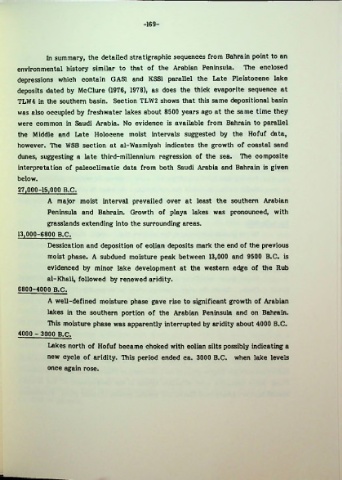Page 193 - Life & Land Use on the Bahrain Islands (Curtis E Larsen)
P. 193
-169-
In summary, the detailed stratigraphic sequences from Bahrain point to an
environmental history similar to that of the Arabian Peninsula. The enclosed
depressions which contain GAS1 and KSS1 parallel the Late Pleistocene lake
deposits dated by McClure (1976, 1978), as does the thick evaporite sequence at
TLW4 in the southern basin. Section TLW2 shows that this same depositional basin
was also occupied by freshwater lakes about 8500 years ago at the same time they
were common in Saudi Arabia. No evidence is available from Bahrain to parallel
the Middle and Late Holocene moist intervals suggested by the Hofuf data,
however. The WSB section at al-Wasmiyah indicates the growth of coastal sand
dunes, suggesting a late third-millennium regression of the sea. The composite
interpretation of paleoclimatic data from both Saudi Arabia and Bahrain is given
below.
27,000-15,000 B.C.
A major moist interval prevailed over at least the southern Arabian
Peninsula and Bahrain. Growth of playa lakes was pronounced, with
grasslands extending into the surrounding areas.
13,000-6800 B.C.
Dessication and deposition of eolian deposits mark the end of the previous
moist phase. A subdued moisture peak between 13,000 and 9500 B.C. is
evidenced by minor lake development at the western edge of the Rub
al-Khali, followed by renewed aridity.
6800-4000 B.C.
A well-defined moisture phase gave rise to significant growth of Arabian
lakes in the southern portion of the Arabian Peninsula and on Bahrain.
This moisture phase was apparently interrupted by aridity about 4000 B.C.
4000 - 3000 B.C.
Lakes north of Hofuf became choked with eolian silts possibly indicating a
new cycle of aridity. TTiis period ended ca. 3000 B.C. when lake levels
once again rose.

